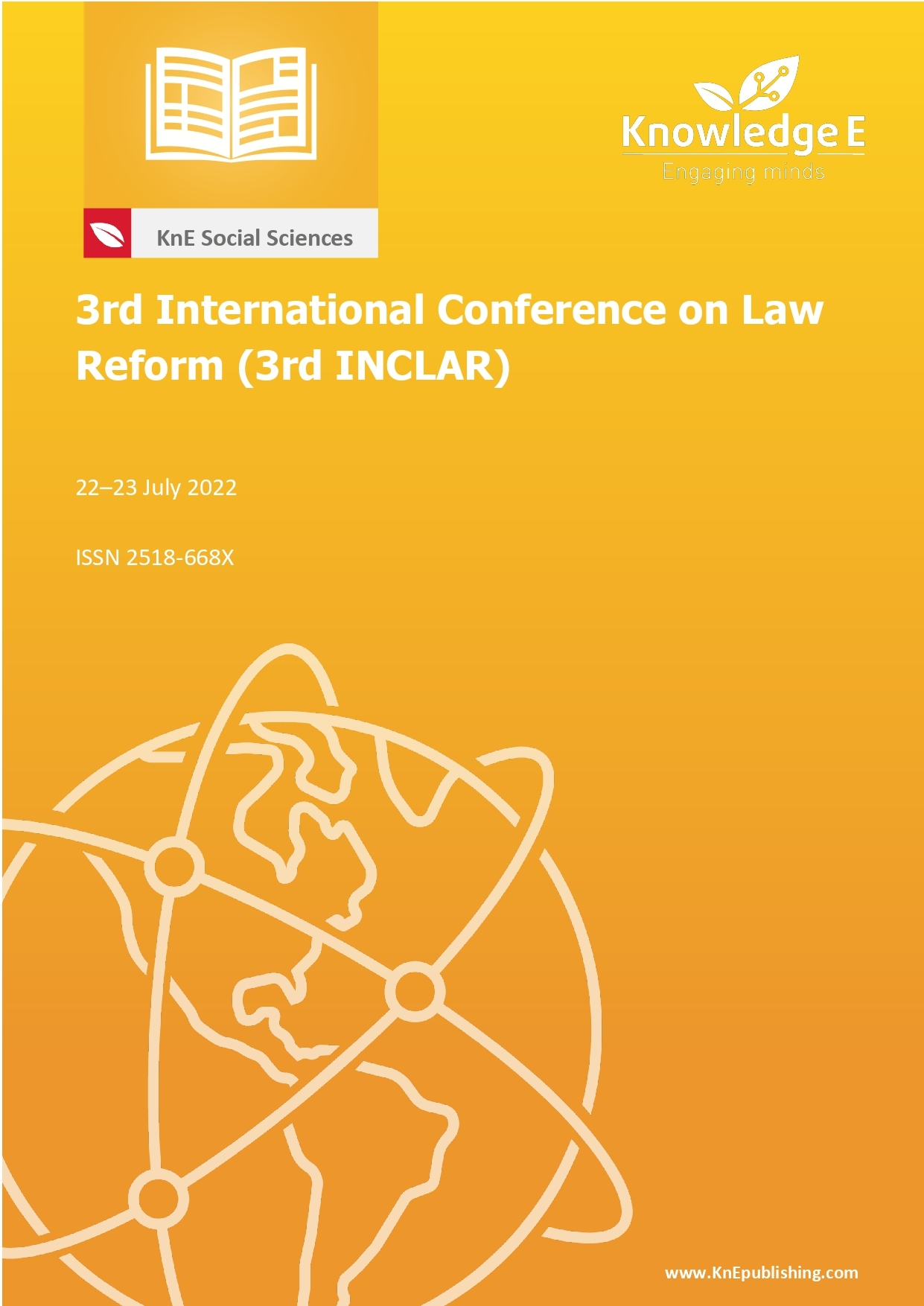Pandemic As a Crime Factor: Reason Mitigating or Aggravating Penal? (The Reflection Post Covid-19 in Indonesia)
DOI:
https://doi.org/10.18502/kss.v7i15.12137Abstract
Crime is part of the form of human behavior and will continue to develop following the dynamics of human life and civilization. There’s no exception that the Covid-19 pandemic that hit the world also had an impact on Indonesia. The impact is not only in the sphere of human health but also in the sphere of social life, including changes in human habits and behavior. Various Indonesian government policies to reduce the spread of Covid-19, such as restrictions on activities outside the home, to prisoner assimilation policies have also influenced changes in human behavior and the economic condition of the community which can be a potential change in the form and rate of crime. Crime will not be separated from the problem of criminal law and punishment, especially modern criminal law that is oriented to the perpetrator and the deed (daad-dader straafrecht) or also known as penal individualization. One of the characteristics of penal individualization is that the crime must be adapted to the characteristics and conditions of the perpetrator, which is elaborated with the view of the ecology school in criminology, a person’s evil deeds are influenced by the environment of the perpetrator (external factors). It becomes a question, is the pandemic condition a factor of crime, or is it a reason for aggravating or mitigating crime for criminals? To answer this question, the author uses a juridical/normative research approach, and it is found that the Covid-19 pandemic as a national disaster can become a mitigating circumstance and aggravating circumstances, in the form of Judicial Mitigating and Aggravating Circumstances.
Keywords: Covid-19, punishment, Indonesia, criminal law, mitigating-aggravating penal
References
[2] Fajrin YA, Triwijaya AF, Ma A. “Double Track System for Criminals Against Homosexuality Background (Ideas in Criminal Law Reform),” Negara Huk. Membangun Huk. untuk Keadilan dan Kesejaht., vol. 11, no. 2, pp. 167–190, 2020.
[3] Taufiq ZF. “Covid 19 dan Angka Kriminalitas: Penerapan Teori-Teori Kriminologi,” JISIP ( Jurnal Ilmu Sos. dan Pendidikan), vol. 4, no. 4, pp. 37–44, 2020.
[4] Badan Pusat Statistik. “Persentase Penduduk Miskin Maret 2020 Naik Menjadi 9,78 Persen,” Badan Pusat Statistik, 2020. [Online]. Available: https://www.bps.go.id/pressrelease/2020/07/15/1744/persentase-penduduk-miskinmaret- 2020-naik-menjadi-9-78-persen.html
[5] Sparrow R, Dartanto T, Hartwig R. Indonesia Under the New Normal: Challenges and the Way Ahead. Bull Indones Econ Stud. 2020;56(3):269–99.
[6] Olivia S, Gibson J, Nasrudin R. Indonesia in the Time of Covid-19. Bull Indones Econ Stud. 2020;56(2):143–74.
[7] Siregar RY, Gunawan AH, Saputro AN. Impact of the Covid-19 Shock on Banking and Corporate Sector Vulnerabilities in Indonesia. Bull Indones Econ Stud. 2021;57(2):147–73.
[8] Biro Humas Kemnaker. “Menaker Ida: 29,12 Juta Orang Penduduk Usia Kerja Terdampak Pandemi Covid-19,” Kementerian Ketenagakerjaan Republik Indonesia, 2020. [Online]. Available: https://kemnaker.go.id/news/detail/menaker-ida-2912-jutaorang- penduduk-usia-kerja-terdampak-pandemi-covid-19
[9] Kaffenberger M. Modeling the Long-Run Learning Impact of the. RISE Insight; 2020. pp. 1–12.
[10] Gillin JL. Economic Factors in The Making of Criminals. Soc Forces. 1925;3(2):248– 55.
[11] Maslow AH. A Theory of Human Motivation. Psychol Rev. 1943;50(4):370–96.
[12] Anwar M. “Asimilasi dan Peningkatan Kriminalitas Di Tengah Pembatasan Sosial Berskala Besar Pandemi Corona,” Adalah Bul. Hukumm dan Keadilan, vol. 4, no. 1, pp. 101–106, 2020.
[13] Cloward RA, Ohlin LE. Delinquency and Opportunity: A Theory of Delinquent Gangs. New York: Routledge; 2013. https://doi.org/10.4324/9781315007274.
[14] Republika.co.id. “Pengungkapan Kasus Pemalsuan Surat PCR di Bandara, Begini Kronologinya,” Republika.co.id, 2022. [Online]. Available: https://www.republika.co.id/berita/r7uuxx370/pengungkapan-kasus-pemalsuansurat- pcr-di-bandara-begini-kronologinya
[15] Bustomi MI. “Dugaan Pemalsuan Hasil Tes PCR Terjadi Lagi, Apa Ancaman Hukumannya?” Kompas.com, 2021. [Online]. Available: https://megapolitan.kompas.com/read/2021/03/02/09434271/setahun-pandemicovid- 19-saat-penimbun-masker-dibekuk-tujuan-cari-untung?page=all
[16] Marks SR. Durkheim ’ s Theory of Anomie ’. Am J Sociol. 1974;80(2):329–63.
[17] Bieber F. Global Nationalism in Times of the Covid-19 Pandemic. Natl Pap. 2022;50(1):13–25.
[18] Lele G. Concurrency as crisis decision-making governance: lessons from Indonesia’s response to the Covid-19 pandemic. Reg Fed Stud. 2021;:1–26.
[19] Featherstone R, Deflem M. Anomie and Strain: Context and Consequences of Merton’s Two Theories. Sociol Inq. 2003;73(4):471–89.
[20] Santoso T, Zulfa EA. Kriminologi. Jakarta: Rajawali Pers; 2012.
[21] Reiss AJ. Delinquency as the Failure of Personal and Social Controls. Am Sociol Rev. 1951;16(2):196–207.
[22] Sari K. “KDRT Mengintai Di Tengah Pandemi,” Kementerian Pemberdayaan Perempuan dan Perlindungan Anak Republik Indonesia, 2020. [Online]. Available: https://www.kemenpppa.go.id/index.php/page/read/31/2707/kdrt-mengintai-ditengah- pandemi
[23] Stickle B, Felson M. Crime Rates in a Pandemic: the Largest Criminological Experiment in History. Am J Crim Justice. 2020;45(4):525–36.
[24] Cheung L, Gunby P. Crime and mobility during the Covid-19 lockdown: a preliminary empirical exploration. New Zeal. Econ. Pap. 2022;56(1):106–13.
[25] Cohen LE, Felson M. Social Change and Crime Rate Trends: A Routine Activity Approach. Am Sociol Rev. 1979;44(4):588.
[26] Utrecht E. Hukum Pidana 1. Bandung, 1986.
[27] Hananta D. “Aggravating and Mitigating Circumstances Consideration on Sentencing.” J. Huk. dan Peradil. 2018; 7(1):87.

